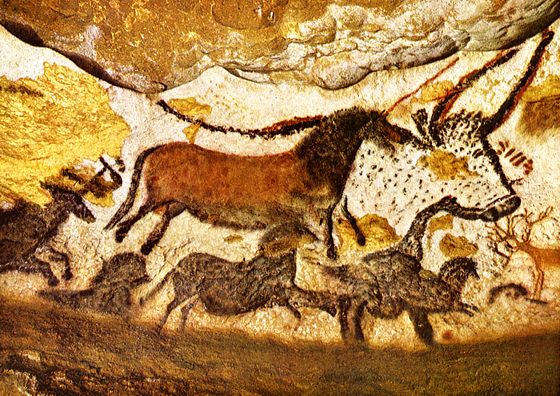
Hall of the Bulls
In 1940, four teenage boys and a dog named Robot stumbled upon Paleolithic drawings in a cave in Lascaux, France. A precise date for the art is difficult to determine but scientists used carbon dating to estimate the age of some charcoal found in the caves, and according to that method, the drawings are about 17,000 years old.
In a cave approximately 66 feet wide and 16 feet high and connected to a number of smaller chambers there are about 2,000 drawings and engravings, mostly of animals: horses, bison, red deer, stags, cats, and aurochs — large, black cattle-like animals that are now extinct.
The chambers have been given evocative names: the Great Hall of the Bulls; the Chamber of Felines; and the Shaft of the Dead Man. In addition to the figures, there also appears to be an Ice Age star chart: clusters of stars that resemble known constellations like Taurus the Bull, the Summer Triangle, and the Pleiades.
Werner Herzog’s film, Cave of Forgotten Dreams, introduces us to these images from 30,000 years ago, painted during the last ice age by Cro-Magnon artists. The film, part history lesson and part inquiry into the nature of human creation. Herzog says that “You sense somehow this is the origin of the modern human soul; this is the origin of art.”

Tang Dynasty mural of bodhisattvas found at the Mogao Caves in Dunhuang, China.
The Diamond Sutra is the world’s oldest book bearing a specific date of publication, 868 A.D. It was printed on a 16-foot scroll using wood blocks. It was discovered in 1907 in Turkestan, among 40,000 books and manuscripts walled up in one of the Caves of the Thousand Buddhas.
Early Buddhist monks made their way from northwest India to inhabit theMogao Caves which came to be known as the “Caves of a Thousand Buddhas.”

The Cave of a Thousand Buddhas is located just outside the town of Dunhuang, also spelled “Tunhuang.”
The Diamond Sutra is a collection of Buddhist teachings ( sutra comes from Sanskrit and means teachings or scriptures) set up as a dialogue between the Buddha and Subhuti, one of his elderly disciples.
It is short and can be read, memoried and recited in an hour.
“As a lamp, a cataract, a star in space
an illusion, a dewdrop, a bubble
a dream, a cloud, a flash of lightning
view all created things like this.”
(Buddha speaking in the Diamond Sutra as translated by Red Pine)
an illusion, a dewdrop, a bubble
a dream, a cloud, a flash of lightning
view all created things like this.”
(Buddha speaking in the Diamond Sutra as translated by Red Pine)
In the Diamond Sutra, the Buddha declares that the sutra will be called “The Diamond of Transcendent Wisdom” because wisdom can cut like a sharp diamond through illusion. In the sūtra, the Buddha has finished his daily walk with the monks to gather offerings of food, and he sits down to rest. Elder Subhūti comes forth and asks the Buddha a question. What follows is a dialogue regarding the nature of perception. The Buddha often uses paradoxical phrases such as, “What is called the highest teaching is not the highest teaching”. Like many of the later Zen koans, the Buddha is generally thought to be trying to help Subhūti unlearn his preconceived, limited notions of the nature of reality and enlightenment.
All conditioned phenomena
Are like dreams, illusions, bubbles, or shadows;
Like drops of dew, or flashes of lightning;
Thusly should they be contemplated.
Are like dreams, illusions, bubbles, or shadows;
Like drops of dew, or flashes of lightning;
Thusly should they be contemplated.
The caves were forgotten until the year 1900, when an itinerant Taoist monk named Wang Yuan Lu happened upon them and began to slowly restore the caves. When he eventually unsealed the caves, there were more than 50,000 texts and paintings. Unsure of what to do with all the manuscripts, he was told to seal the cave back up.
An archaeologist, Aurel Stein (a Hungarian working for the British) convinced Wang Yuan Lu to part with a huge amount of manuscripts and left the Caves of a Thousand Buddhas with 24 cases of manuscripts and five cases of paintings and relics, and in return, gave Wang just £130 and the promise that he wouldn’t tell anyone what Wang had done. The Diamond Sutra was among these 7,000 manuscripts.
Stein was knighted in England but was rightly hated in China for stealing national treasures and later scholars came and took more of the treasures, even chipping murals off the walls.,

A page from the Diamond Sutra, printed in the 9th year of Xiantong Era of the Tang Dynasty, i.e. 868 CE. Currently located in the British Library, London which says it is "the earliest complete survival of a dated printed book."
